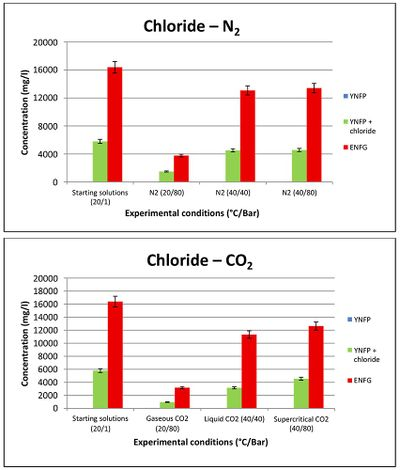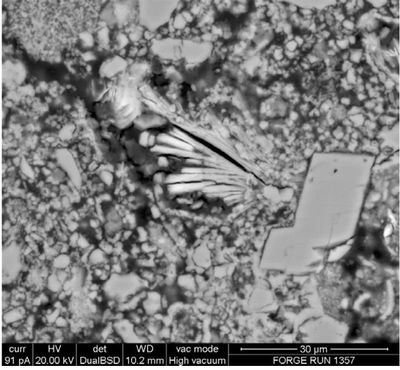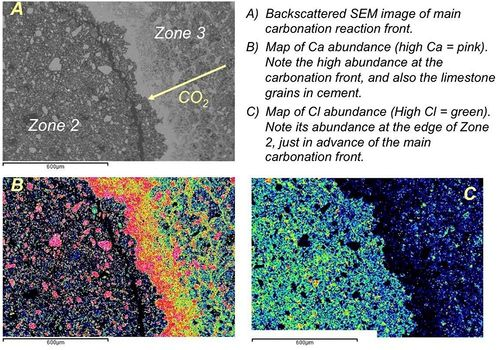OR/13/004 Potential impact of CO2 on repository safety functions
| Rochelle, C A, Purser, G, Milodowski, A E, Noy, D J, Wagner, D, Butcher, A, and Harrington, J F. 2013. CO2 migration and reaction in cementitious repositories: A summary of work conducted as part of the FORGE project. British Geological Survey Internal Report, OR/13/004. |
Information presented in the previous sections clearly demonstrates that carbonation of cement can alter its permeability. At microscopic scales carbonation results in a patchwork of high porosity/permeability domains enclosed by thin low porosity/permeability zones. At a somewhat larger (millimetric) scale, there was some evidence that unconfined samples could develop stress cracking close to the carbonation reaction fronts, though these features were very localised and could be filled by secondary carbonates as the reaction fronts moved through the sample. For larger samples (several cm in size), the net effect of carbonation is to reduce permeability — at least halving its original permeability.
Such reductions in permeability are beneficial in terms of containment as they would act to limit radionuclide migration. The NRVB cement used in this study is designed to be relatively permeable, so as to safely vent gas pressure build-up within the canisters. The reductions in permeability observed in the tests conducted here, still allow for some gas migration through the samples of cement, albeit at a reduced rate. As a consequence, it seems unlikely that carbonation would cause overly high gas pressures to develop in the waste canister or around its vent, and so the risk of mechanical disruption appears low. That said, dissolved CO2 was particularly effective at reducing permeability (by about 3 orders of magnitude, compared to a halving for gaseous or supercritical CO2). Around the vents of waste canisters there could therefore be different regions of carbonation having different permeability, depending upon whether they were carbonated under conditions dominated by predominantly dissolved CO2 or free phase CO2. Assessing which type of carbonation will dominate will require consideration of the complex relationships between gas generation rates, cement permeability, and rate of cement reaction.
Most of the carbonation observed was relatively uniform on greater than mm scales. However, a small number of (mainly diffusion) samples showed some evidence for carbonation along specific zones. These are thought to relate to differential settling during cement pouring and curing. Similar features could form in a repository setting, and could provide preferential routes for CO2 migration if they occurred on a large scale. Such cement heterogeneity could be minimised through the use of organic additives to enhance cement flow behaviour. However, Francis et al. (1997)[1] note that the presence of such organics may enhance the mobility of some radionuclides. It will be important therefore, to consider carefully the pros and cons of adding additives to repository buffer/backfill cement.
There is clear evidence that cement carbonation can result in a lowering of cement pH buffering capacity as many metallic radionuclides have low solubility under alkaline conditions, but higher solubility as pH decreases. Potentially therefore, carbonation may facilitate local radionuclide migration. That said, if as seems likely, the repository contained an excess of cement that was more than sufficient to react with all the produced CO2, then overall pH buffering to alkaline conditions could still be effective for many parts of the repository.
It is anticipated that carbonation reactions would help immobilise 14C if that were present. However, one less expected observation concerning solute migration was the enhanced localised uptake of dissolved chloride (Cl-) by the cement. 36Cl presents particular issues within repositories, due to its long half-life, ease of uptake into biological systems, and relative mobility in many settings. Uptake of Cl- was most clearly revealed by significant decreases in dissolved Cl- in the experiments using more ‘evolved’ porewater compositions (i.e. porewaters reflecting interaction between saline groundwater and the cement) (Figure 16).

Many of the experiments showed decreases in dissolved Cl-, not just those pressurised with CO2. The NRVB cement appeared to be immobilising Cl-, especially at lower temperatures (in this study 20°C) where Cl- uptake was especially favoured. Smaller, but still significant, amounts of additional Cl- were taken up in equivalent experiments pressurised with CO2. The additional stability provided by the presence of CO2 possibly suggests that it may exist as part of a solid-solution series with Cl- and CO3-endmembers.
Detailed mineralogical observations in the region around carbonation fronts revealed the presence of small amounts of two fine-grained, Cl-rich solid phases. One was a gel-like Cl-rich CSH, the other was only found in the 20°C experiments and occurred as fine-grained radial fibrous crystal aggregates of a calcium chloroaluminate phase, probably hydrocalumite (Ca4Al2O6Cl2.10H2O) (Rochelle et al., 2013[2]; Milodowski et al., 2013[3]) (Figure 17). Element mapping clearly showed that these Cl-rich phases were found on the cement-side of the reaction front (Figure 18). It would appear that they are only stable under higher pH conditions (i.e. where CSH phases were still present).


The secondary Cl-rich phases were only stable where CSH was present, and we envisage that they progressively breakdown as carbonation reactions consume the CSH around them. The released Cl- then migrates via diffusion towards the remaining CSH and re-precipitates. This dissolution/precipitation process continues until all of the CSH is reacted (in the case of a limited quantity of cement), at which point the Cl- would be released back into solution.
The uptake of Cl- in CO2-free cement systems concurs with observations undertaken as part of previous experimental buffer/backfill cement studies (Glasser et al., 1998[4]). Cl- uptake in CO2-rich systems has also been previously noted as part of borehole stability studies for the deep underground storage of CO2. Rochelle et al. (2006[5], 2009[6]) found increased Cl- uptake in CO2-rich experiments compared to CO2-free experiments, and Carey et al. (2007)[7] report a Cl-rich secondary phase in recovered samples of borehole cement that had been exposed to CO2-rich fluids for 30 years.
The apparent likely occurrence of Cl-rich phases within cementitious repositories, raises the question of whether performance assessment calculations could include them (many current approaches assume conservative, i.e. non-reacting, behaviour of Cl-). Inclusion of such phases would likely retard the overall predicted migration of 36Cl, lowering eventual releases to the biosphere, and hence improving safety calculations. Equally, they may allow for higher initial loadings of 36Cl in the waste. It would be useful to investigate these Cl-rich phases further.
References
- ↑ FRANCIS, A J, CATHER, R, and CROSSLAND, I G. (1997). Development of the Nirex reference vault backfill; report on current status in 1994. Nirex Science Report S/97/014, United Kingdon Nirex Limited, 57p.
- ↑ ROCHELLE, C A, and MILOWDOWSKI, A E. (2013). Carbonation of borehole seals: comparing evidence from short-term lab experiments and long-term natural analogues. Applied Geochemistry, 30, 161–177.
- ↑ MILODOWSKI, A E, ROCHELLE, C A, and PURSER, G. (2013). Uptake and retardation of Cl during cement carbonation. Procedia Earth and Planetary Science, 7, 594–597.
- ↑ GLASSER, F P, TYRER, M, QUILLIN, K, ROSS, D, PEDERSEN, J, GOLDTHORPE, K, BENNETT, D, and ATKINS, M. (1998). The chemistry of blended cements and backfills intended for use in radioactive waste disposal. United Kingdom Environment Agency R&D Technical Report P98, ISBN: 1857 05 157 2, 332pp.
- ↑ ROCHELLE, C A, BATEMAN, K, MILODOWSKI, A E, KEMP, S J, and BIRCHALL, D. (2006). Geochemical interactions between CO2 and seals above the Utsira Formation: An experimental study. British Geological Survey Commissioned Report, CR/06/069. 86 pp.
- ↑ ROCHELLE, C A, MILODOWSKI, A E, LACINSKA, A, RICHARDSON, C, SHAW, R, TAYLOR, H, WAGNER, D, and BATEMAN, K. (2009). An experimental investigation of the geochemical interactions between CO2 and borehole materials. British Geological Survey report, OR/09/039, 84p.
- ↑ CAREY, J W, WIGAND, M, CHIPERA, S J, WOLDEGABRIEL, G, PAWAR, R, LICHTNER, P C, WEHNER, S C, RAINES, M A, and GUTHRIE, J. 2007. Analysis and performance of oil well cement with 30 years of CO2 exposure from the SACROC Unit, West Texas, USA. International Journal of Greenhouse Gas Control, 1, 75–85.